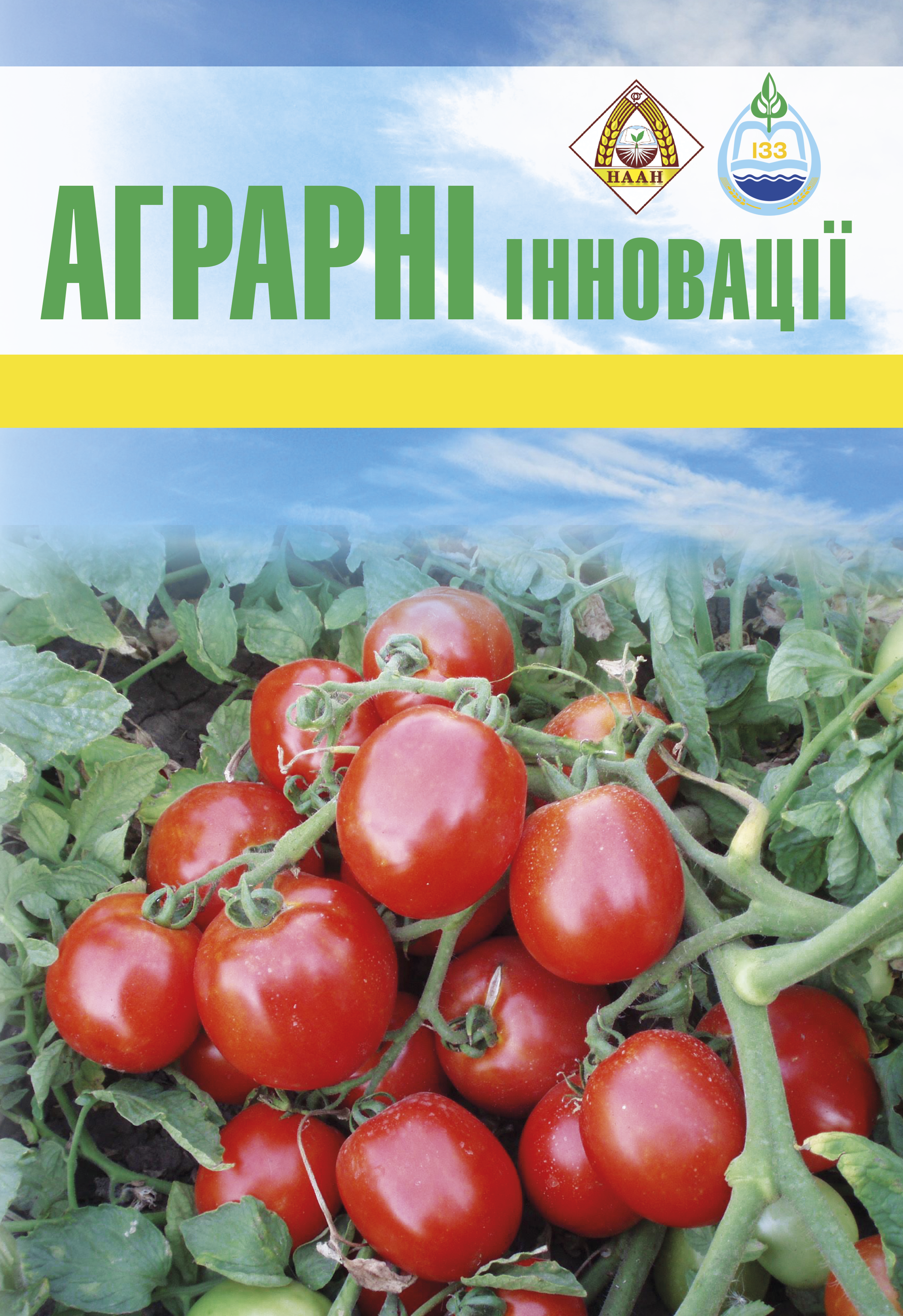Формування якості насіння ріпаку озимого залежно від комплексних варіантів його удобрення
Анотація
Метою досліджень було встановити особливості формування жирнокислотного складу насіння ріпаку озимого залежно від комбінаторики варіантів системи удобрення. Методи. Дослідження було проведено впродовж 2021–2024 років на базі ТОВ «ВІН-АГРО ГРУП» на сірих лісових грунтах з середнім потенціалом родючості. Повторність у досліді чотирьохразова. Розміщення варіантів – систематичне у два яруси. Дослід передбачав вивчення таких факторів: А – річні умови періоду вегетації, В – варіант основного удобрення, С – застосування регуляторів росту, D – система позакореневих підживлень. Результати. Доведена можливість корегувати і змінювати як вміст олії у насінні ріпаку озимого, так і її жирнокислотний склад за рахунок комбінованого застосування оптимізованих варіантів основного удобрення та системи позакореневих підживлень Встановлено оптимальні варіанти удобрення, які дозволяють отримати олійність високо інтенсивних гібридів ріпаку озимого на рівні 48,0% з сумою технологічно цінних жирних кислот на рівні 85–87% у загальній структурі її жирно кислотного складу. Висновки. Визначено агротехнологічно доцільний варіант удобрення ріпаку озимого, який передбачає: BBCH 00: Діамофоска N-9% P-25% K-25% (100 кг/га) + Росаферт 5-10-25+10S (120 кг/га); ВВСН 14-18: Регулятор Букат ((тебеконазол 500 гр/л) (0,5 л/га)); ВВСН 19-20 (по мерзлоталому грунту): Росаферт NPK 16-14-07 (100 кг/га) + КАС-32 (200 л/га) + Тіосульфат амонію (ATS) (30 л/га)); ВВСН 35-39: Карамба Турбо 0,65 л/га + Букат 0,35 л/га; ВВСН 31-34: Розалік (B, Mo, S) (1 л/га) + ад’ювант Спрей-Ейд (0,08 л/га); ВВСН 51–53: Розасоль 18-18-18+МЕ (3 кг/га) + ад’ювант Спрей-Ейд (0,08 л/га). Застосування даної системи комбінованого удобрення дозволяє максимально реалізувати генотипів потенціал олійності гібридів ріпаку на рівні 46–48% за оптимізованого співвідношення основних компонентних жирних кислот.
Посилання
2. Zatonski W., Campos H., Willett W. Rapid declines in coronary heart disease mortality in Eastern Europe are associated with increased consumption of oils rich in alphalinolenic acid. European Journal of Epidemiology. 2008. Vol. 23. P. 3–10.
3. Zadernowski R., Sosulski F. Composition of total lipids in rapeseed. Journal of the American Oil Chemists’ Society. 1978. Vol. 55. P. 870–872.
4. Wang C, Li Z, Wu W. Understanding fatty acid composition and lipid profile of rapeseed oil in response to nitrogen management strategies. International Food Research. 2023 Vol. 165. 112565.
5. Chew S.C. Cold-pressed rapeseed (Brassica napus) oil: Chemistry and functionality. Food Research International. 2020. Vol. 131. 108997.
6. Coonrod D., Brick M.A., Byrne P.F., Debonte L., Chen Z. Inheritance of long chain fatty acid content in rapeseed (Brassica napus L.). Euphytica. 2008. Vol. 164. P. 583–592.
7. Liersch A., Bocianowski J., Bartkowiak-Broda I. Fatty acid and glucosinolate level in seeds of different types of winter oilseed rape cultivars (Brassica napus L.). Communications in Biometry and Crop Science. 2013. Vol. 8. P. 39–47.
8. Kumar P.R., Tsunoda S. Variation in oil content and fatty acid composition among seeds from the Cruciferae. In: Tsunoda S, Hinata K, Gómez-Campo C (Eds). Brassica Crops and Wild Allies. Japan Scientific Societies Press,Tokyo. 1980. P. 235–252.
9. Arkadiusz S., Wojtkowiak, K., Pietrzak-fiecko R. Nutrient content, fat yield and fatty acid profile of winter rapeseed (Brassica napus L.) grown under different agricultural production systems. Chilean journal of agricultural research. 2017. Vol. 77. № 3. Р. 266–272.
10. Faraji A. Oil concentration in canola (Brassica napus L.) as a function of environmental conditions during seed filling period. International Journal of Plant Sciences. 2012. Vol. 6. № 3. P. 267–278.
11. Cwalina-Ambroziak B., Stepien A., Kurowski T.P., GlosekSobieraj M., Wiktorski A. The health status and yield of winter rapeseed (Brassica napus L.) grown in monoculture and in crop rotation under different agricultural production systems. Archives of Agronomy and Soil Science. 2016. Vol. 62. P. 1722–1732.
12. Ngezimana W., Agenbag G.A. Nitrogen and sulfur effects on macro and micronutrient contents in canola (Brassica napus L.) grown on acidic soils of the Western Cape province of South Africa. Communications in Soil Science and Plant Analysis. 2014. Vol. 45. P. 1840–1851.
13. Rathke G.W., Behrens T., Diepenbrock W. Integrated nitrogen management strategies to improve seed yield, oil content and nitro-gen efficiency of winter oilseed rape (Brassica napus L.): A review. Agriculture, Ecosystems and Environment. 2006. Vol. 117. P. 80–108.
14. Sienkiewicz-Cholewa U., Kieloch R. Effect of sulphur and micronutrients fertilization on yield and fat content in winter rape seeds (Brassica napus L.). Plant, Soil and Environment. 2015. Vol. 61. №(4). P. 164–170.
15. Spychaj-Fabisiak E., Murawska B., Pacholczyk L. Values of quality traits of oilseed rape seeds depending on the fertilisation and plant density. Journal of Elementology. 2011. Vol. 16. P. 115–124.
16. Brennan R. F., Mason M. G., Walton G. H. Effect of nitrogen fertilizer on the concentrations of oil and protein in canola (Вrassica napus) seed. Journal of Plant Nutrition. 2000. Vol. 23. № 3. P. 339–348.
17. Shilan H. S., Hama S. J. Effect of NPK and organic fertilizers on yield and seed oil content of rapeseed (Brassica napus L.). Iraqi journal of agricultural sciences. 2022. Vol. 53. № 4. P. 878–889.
18. Spasibionek S., Wielebski F., Liersch A., Walkowiak M. The Influence of Nitrogen and Sulfur Fertilization on Oil Quality and Seed Meal in Different Genotypes of Winter Oilseed Rape (Brassica napus L.). Agriculture. 2024. Vol. 14. № 8. 1232.
19. Omidi H., Tahmasebi Z., Badi H.A.N., Torabi H., Miransari M. Fatty acid composition of canola (Brassica napus L.) as affected by agronomical, genotypic and environmental parameters. Comptes Rendus Biologies. 2010. Vol. 33. P. 248–254.
20. Shirani Rad A.H., Ganj-Abadi F., Jalili E.O., Eyni-Nargeseh H., Safavi Fard N. Zn foliar spray as a management strategy boosts oil qualitative and quantitative traits of spring rapeseed genotypes at winter sowing dates. Journal of Soil Science and Plant Nutrition. 2021. Vol. 21. № 2. P. 1610–1620.
21. Carré, P., Citeau, M., Robin, G., Estorges M. Hull content and chemical composition of whole seeds, hulls and germs in cultivars of rapeseed (Brassica napus L.)’. Oilseeds and fats, Crops and Lipids. 2016. Vol. 23. № 3. A302.
22. Kozłowska-Strawska J. Fat Content and Fatty Acid Composition in Oilseed Rape Grown in the Lubelski Region under Different Levels of Soil Sulphur Fertility. Ecological Chemistry and Engineering. A. 2012. Vol. 19. P. 191–201.
23. Мацера О.О. Вплив елементів технології вирощування на розвиток рослин, врожайність та якість насіння озимого ріпаку. Danish Scientific Journal. 2020. Issue 36 (2). С. 7–15.
24. Guan M., Huang X., Xiao Z., Jia L., Wang S., Zhu M., Qiao C., Wei L., Xu X., Liang Y., Wang R., Lu K., Li J., Qu C. Association Mapping Analysis of Fatty Acid Content in Different Ecotypic Rapeseed Using mrMLM. Frontiers in Plant Science. 2019. № 9. 1872.
25. Gacek K., Bayer P.E., Bartkowiak-Broda I., Szala L., Bocianowski J., Edwards D., Batley J. Genome-Wide Association Study of Genetic Control of Seed Fatty Acid Biosynthesis in Brassica napus. Frontiers in Plant Science. 2017. Vol. 7. 2062.
26. Zhou W. Application and development prospects of rapeseed oil in biodiesel production. Journal of Energy Bioscience. 2024. Vol. 15. № 2. P. 74–86.
27. Методика Державного сортовипробування сільськогосподарських культур. Методи визначення показників якості рослинної продукції / [за ред.О. М. Гончара]. К.: Алефа, 2000. Вип. 7. 144 с.
28. Karydogianni S., Roussis I., Kakabouki I., Mavroeidis A., Stavropoulos P., Efthimiadou A., Katsenios N., Giannoglou M., Katsaros G., Beslemes D., Triantafyllidis V., Bilalis D. Seed oil content, oil yield and fatty acids composition of black mustard [Brassica nigra (L.) Koch] in response to fertilization and plant density. Notulae Botanicae Horti Agrobotanici Cluj-Napoca. 2023. Vol. 51. № 1. 13061.
29. Tsytsiura Y. Evaluation of oilseed radish (Raphanus sativus L. var. oleiformis Pers.) oil as a potential component of biofuels. Engenharia Agrícola, Jaboticabal. 2023. Vol. 43. Special issue. e20220137.
30. Karydogianni S., Roussis I., Mavroeidis A., Kakabouki I., Tigka E., Beslemes D., Stavropoulos P., Katsenios N., Tsiplakou E., Bilalis D. The influence of fertilization and plant density on the dry matter yield and quality of black mustard [Brassica nigra (L.) Koch]: An alternative forage crop. Plants. 2022. Vol. 11. 2683.
31. Varényiová M., Ducsay L. Effect of increasing spring doses of nitrogen on yield and oil content in seeds of oilseed rape (Brassica napus L.). Acta Fytotechnica et Zootechnica. 2016. Vol. 19. P. 29–34.






